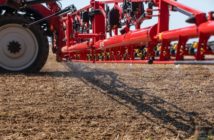Following the T2 fungicide spray, there are one or two agronomic decisions which can significantly increase the chances of achieving quality premiums for milling wheat varieties and maximising yields in feed wheats. Fundamentally these decisions need to focus on managing the nutrition and health of the wheat plant during grain fill; and whilst we often compartmentalise these two factors, it is important to remember that they are inter-related.
To achieve the grain protein demands for a milling sample, the crop will require extra nitrogen. Nitrogen is fundamental to many aspects of plant growth, including the manufacture of chlorophyll; but for milling quality its role as a building block for all proteins is especially relevant.
Because of the season-long need for nitrogen it is important to ensure that the crop receives extra N later in the season, and for grain protein enhancement, this normally means application between flag-leaf and ear emergence. One area which can cause some confusion, is the fact that high yield can cause a dilution in the amount of grain protein per tonne, so it’s important to ensure expected yield is included in any N calculations.
Fungicide choice can also have an important role in maintaining grain protein; so when designing your ear spray, consider all the factors including control of ear diseases (Fusarium complex), flag leaf diseases and physiological responses which directly affect nitrogen uptake.
For control of the Fusarium complex it is widely accepted that one of the following three azoles should be used; metconazole, tebuconazole or prothioconazole. To satisfy the needs of the DON mycotoxin risk assessment, these should be applied at a minimum of half-dose (e.g. 1.0 l/ha for Brutus).
This year grower’s also have the option of using Librax (Xemium + metconazole) on the ear. Whilst a maximum of two SDHIs are permitted in cereals, there are plenty of cases this year where growers opted for a cheaper, non-SDHI solution at T1 to reduce input costs or simply because crops looked clean at application. However, a number of factors have resulted in high curative disease pressure at T2 and now it’s imperative every effort is made to protect the ear from disease as the T3 timing approaches.
Whilst it is typical to consider Fusarium as the key target for T3, make sure you also cover foliar diseases too. In many seasons, most of the yield increase from the ear spray comes from a disease control top-up to the flag-leaf fungicide and this year, there is still plenty of yellow rust and Septoria kicking around. So ensure you have good coverage of rusts and Septoria from your active ingredient choice. A litre of Brutus will give good control of ear diseases, whilst strongly boosting rust and Septoria protection. Containing both epoxiconazole (the strongest rust active) and metconazole, Brutus is the ideal choice. Where growers haven’t used an SDHI at T1, Librax is an excellent option for T3.
Comet 200 (pyraclostrobin) is a very useful addition to the ear spray, provided the crop has not already received two strobilurin applications. It will give very strong activity against both yellow and brown rusts, either of which can infect the ear, and it will also give a useful boost to grain protein levels through its activity on the plant.
Pyraclostrobin has been shown to directly boost one of the enzymes within the plant which is responsible for using nitrogen; this eases a limiting step for nitrogen usage and can help overcome the tendency for increased yields causing a dilution of grain protein. The effect of Comet 200 on nitrogen is clearly illustrated in the ADAS trial in Graph 1 which shows that the addition of Comet 200 ensures a much more even uptake of N across the dose response curve.
So to cover all the bases during grain fill for quality wheats, use one of the relevant azoles at T3 at a minimum of half dose, with Comet 200 for extra disease control and its ‘pro-protein’ physiological effects which help with grain protein management.
While pyraclostrobin can improve N uptake many varieties, especially milling varieties, will benefit from a top-up application of nitrogen in the form of a liquid applied to the ear when grain is at the milky stage.
Trials performed by BASF and KWS in recent years have investigated this relationship and found that for a high-yielding Group 1 variety, such as KWS Trinity, a foliar top-up of about 40kg N/ha can be enough to raise grain protein to the 13% needed to meet full specification.
Similarly, trials with new Group 2 milling variety KWS Siskin suggest that while it has a greater ability to build grain protein maintaining yield, but that it is also likely to benefit from a foliar application of nitrogen, though the rate will be dependent on the intended market.



